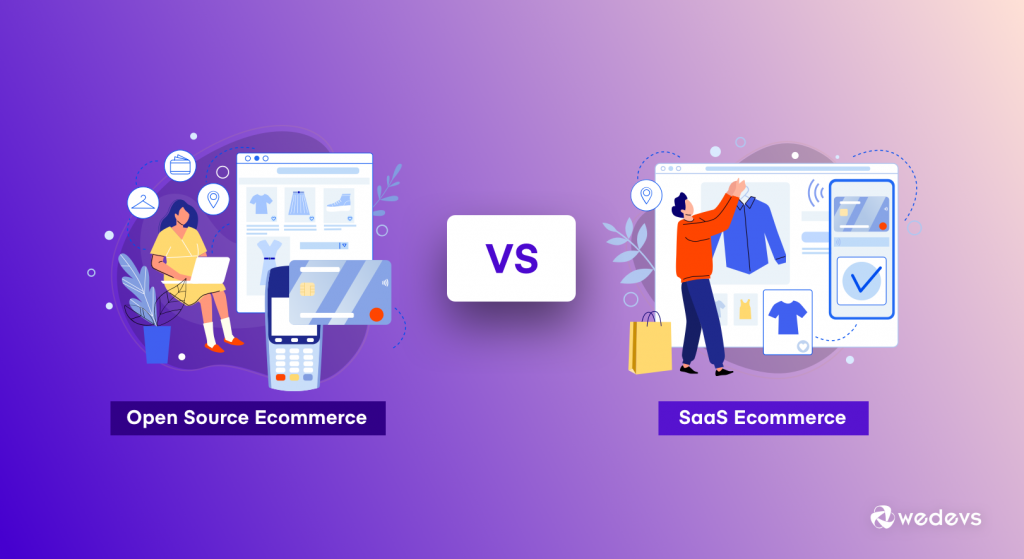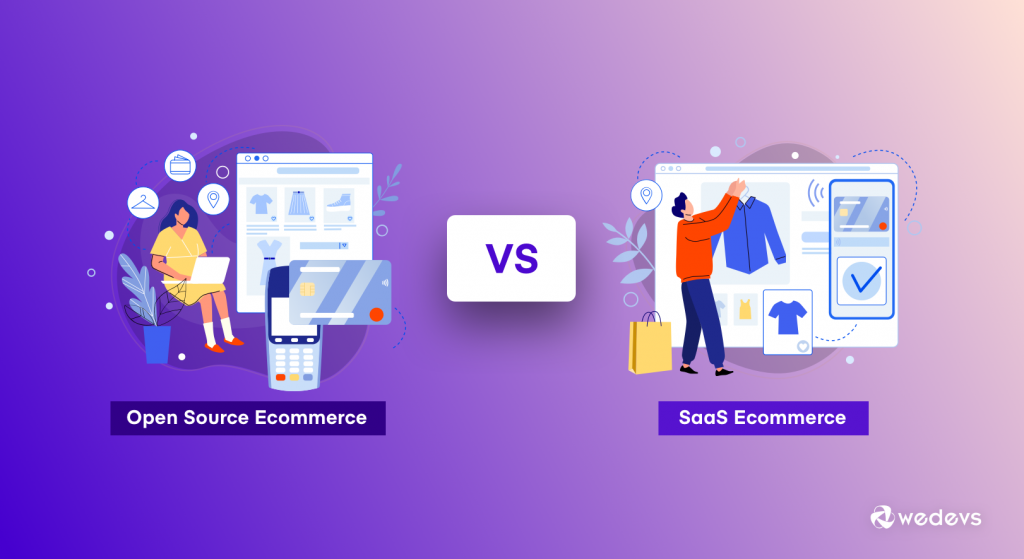
How to Conduct a Sprint Planning Meeting to Ensure Your Business Success
Open Source or SaaS, which platform should you use for your new eCommerce site? This is probably the first question you would ask yourself when you decide to get into the eCommerce business for the very first time. While the battle for Open Source vs SaaS has been going on for too long now. People nowadays are smart and like to compare different platforms before they actually settle for the one they want.
The evolution of online shopping has seen massive growth over the last decade or so. This incurred rapid growth in eCommerce and its platform over the years. But while you decide to get into the eCommerce business, it could become a headache for you when you choose the platform for it.
Picking a platform for eCommerce means you will at least be occupied with it for the next few years unless you decide to start the business all over again or shut your previous business site all of a sudden. And to make the right pick, you need to understand the different aspects, features, benefits, and limitations of each platform.
This could also include the cost, setup, maintenance, support, ease of use, flexibility, security, and more. All these determinants could become a deciding factor for anyone wanting to get started with their eCommerce business.
So let’s have a look at all the essential functionalities, advantages, features to get an overall idea about these two popular platforms for eCommerce.
Open Source vs SaaS eCommerce: The Key Differences That Sets Them Apart

More than anything people want to know in what areas both of these platforms differ from each other. This makes it easier for potential eCommerce users to compare and decide on the platform they need to use.
These differences will surely help you understand the key sector of these two platforms better. So let’s look at some of the key differences that Open source and SaaS platform for eCommerce possesses in terms of:
Cost & Expenses
Open Source eCommerce
Even though the open-source platforms are generally free, but when you add up the cost of its hosting, development, customizations, integrations, security & compliance, this could cost up to several thousands of dollars every year.
But as an eCommerce platform, this expense over the years is not much when you look at the endless option you get to customize and develop the system.
SaaS eCommerce
On the other hand, SaaS follows a subscription-based business model. This means your business will have to subscribe to a monthly or yearly plan and pay a fixed subscription fee for it.
This payment model is totally scaleable and the business can downgrade or upgrade to the various plans depending on the business requirement.
Technical Aspects

Open Source eCommerce
One of the drawbacks of open source is the amount of time and cost that it requires to fulfill its technical work. Most of them need to hire developers to get this work done.
Technical work related to hosting, installations of the platform, PCI security compliant & software updates, and maintenance of the backend interface, etc, need proper guidance and monitoring all the time in the open-source platform.
SaaS eCommerce
Now, here on this platform, almost all the technical work is done and managed by the service provider for you. Once you have decided to launch your eCommerce with a SaaS platform, you will no longer require to worry about its hosting, software updates, installations, security, setup, etc.
It is commonly designed in such a way that any non-techie person will be able to manage your online store easily.
Setup & Installation

Open Source eCommerce
It is not too difficult to set up and install either of the platforms. Moreover, open-source provides the option of its installation at zero expense.
But when it comes to setting up the platform for an eCommerce site you will have to do everything from the scratch on this platform.
SaaS eCommerce
On the other hand, on the SaaS platform, you will mostly have to opt-in for a free trial before you actually decide to subscribe to their services. You do not need to start everything from the scratch either.
Many of the processes will already be done by the service provider too. Moreover, the best part is you will get access to a vast range of pre-designed, themes, plugins, modules, add-ons libraries. You can even build your site simply by drawing and drooping its elements.
User-friendliness & Flexibility

Open Source eCommerce
Sometimes as an eCommerce site owner you might need to use third-party tools for accounting, warehouse, inventory management, etc, to boost some of your application’s functionalities.
But the integration process of these extensions might be a little tricky & get a little longer if you do not have any prior coding knowledge.
SaaS eCommerce
Whereas, on the SaaS platform, there are thousands of third-party application integration options. So anyone can integrate them without any hassle even if they don’t have extensive prior coding knowledge.
It is as simple as plug-and-play. The ease of use and the flexibility enable you to spend less time learning technical features. Moreover, you get to spend more time exploring and implementing new eCommerce marketing strategies.
Design & Customization

Open Source eCommerce
Both the eCommerce platform has basic design and customization needs to be fulfilled. In the case of open-source, it is a platform that supports the best design and customization functionalities.
So there is no limit when it comes to handling your eCommerce customization and adapting to the design and development of your e-store. Due to its easy design and customization option, most companies decide to opt for open-source platforms for their eCommerce.
How To Avoid Product Duplication On Import In WooCommerce
Note: If you have a WordPress platform for your eCommerce site, then you can effortlessly design your site with the Happy Elementor Addons.
SaaS eCommerce
It is already mentioned above that SaaS eCommerce platforms are well-known for their easy and hassle-free setup procedure. Not to mention its offering of extensive marketplace-related apps that increase the functionality of your eCommerce cart abandonment, email marketing, customer support, and more.
Even after all that there is a restriction in the access of its source code which doesn’t allow the user to edit or update it for their own use. Due to this reason, the capabilities of customizing features, plugins, themes, and performance are also limited.
Also Read: How To Start Your Online Web Design Business
Website Security & Compliance

Open Source eCommerce
Every eCommerce website’s security and PCI compliance are the top most important thing that builds trust among customers. With an open-source platform, you yourself are responsible to ensure the security of your website.
You can pick your own security tool to keep your eCommerce site safe & secured from outside threats. Moreover, You will need to make sure, that your security firewall is up-to-date with bug fixes and meets the PCI compliance standards.
SaaS eCommerce
Now in the case of the SaaS platforms, the service providers are responsible for taking care of the website’s security concerns. They will handle and look after the security as well as the PCI compliance for your eCommerce site.
They will even release new security updates whenever it is required to keep your eCommerce site protected. From top to bottom, they take all the necessary measures for your website’s security.
Also Read: Best Security Tools To Protect Your WordPress Website
Maintenance & Support

Open Source eCommerce
Just like the security of the eCommerce site, you will have to be responsible for this platform’s maintenance and support. This means you have to take care of the administration and infrastructure of the platform as well.
More so, you will need to look out for all the software upgrades as well as updates. If any issues occur within your system, then you will have to find a resolution and make all the fixes on your own.
Note: If you have a WooCommerce site but you don’t have the budget or time to maintain and manage your marketplace, then you can turn to a complete marketplace maintenance & support service provider, weCare
SaaS eCommerce
Now when it comes to the maintenance of a SaaS platform for eCommerce, this requires full-on effort from the service provider’s end. On an on-going basis, you get software updates from the host and also keep a lookout for any upgrades required as well.
From the user’s end, you will not need to look after the server maintenance or performance issues and more. So this means you will always have someone to go to, whenever you get any issue or stuck with the system or applications. As it is fully their responsibility to fix all these issues for you.
Open Source vs SaaS eCommerce: Pros and Cons
We are done with the key differences and similarities of these two preeminent platforms for eCommerce. And now it’s time to understand its basic advantages and limitations. This would certainly give you a better idea about these two platforms and why you should get one over the other.
Open Source
| Pros | Cons |
|---|---|
| Fully customizable due to control over the source code | Modifying the source code can be complex |
| Very helpful, strong, and vast community support | Has some security vulnerabilities |
| Built with the future generation in mind | Heavy maintenance is required to keep it up and running |
| Highly scaleable when you start small as a business | |
| Fast, reliable & lower in cost solution |
Open Source vs SaaS
Examples of some top Open Source eCommerce include:
- WooCommerce
- Magento
- OpenCart
SaaS
| Pros | Cons |
|---|---|
| Quick setup ability for faster market launch | Lack of variation in terms of using certain applications only |
| Easy to use & implement | Alteration or customization of source code not possible |
| Fast & secured eCommerce platform | Unavailability of advanced customization for complex business processes |
| Scaleable with your business growth | Lacks in B2B business needs |
| Strong community and customer support |
Open Source vs SaaS
Example of some top SaaS eCommerce include:
- Shopify
- BigCommerce
- Squarespace
Final Verdict: Which One Should You Pick For Your Online Business
It is quite clear that there is no shortage of eCommerce platforms out there in the market today. So it could get a little confusing for the new eCommerce merchant to know which one to pick out of them for their business.
But the below table would hopefully help you with your decision regarding picking one of these platforms. And you will probably be able to determine the type of eCommerce platform you should go for after this. So here it goes:
| Choose Open Source Platform If | Choose SaaS Platform If |
|---|---|
| You need your own development roadmap with multiple integrations for your unique products. | Customers don’t want to be involved in extensive features & functionalities and they do not have many unique products or external integrations. |
| You want to share profit per sale and do not want to pay annual rental fees. | You are cost-conscious about your business and have a low IT budget as well focuses more on the stabilization of the business. |
| Improving and innovating your customer experience is your goal to gain a competitive advantage. | Your business is in the startup and expansion phases of growth, typically in its first 3 years. |
| You want to own your customer’s data and hosting. | You need an eCommerce business model that has a very straightforward cost and implementation process with a platform that is completely managed by the service provider. |
Open Source vs SaaS Comparison
What’s More?
Besides all these, you should also know that open source means license/owner-free code. And it is bundled with a number of essential modules. You can do any type of customization as per your need to your eCommerce site with it. On the other hand, the SaaS platform is also very popular for developing eCommerce sites that have pre-built & configurable tools that enables its user to choose from a wide range of features & functionality.
Lastly, above all, whether you go for your eCommerce business with an Open Source or SaaS platform, you will always need to make sure you have the right settings and functionalities available for you. Both these platforms consist of features and prospects that would cater to all different kinds of users. It will be upto you now to understand all the basic usable option offered by these two prominent platforms for your eCommerce.
Choose Your eCommerce Platform Wisely To Turn Your e-Business a Successful One

Well if you look at the detailed differences and comparison above, you will probably find it difficult enough to come to any conclusion regarding picking any of these two platforms unless you know what exactly you need or want in it.
From the outside, one can’t really call any one of these platforms outright best. But if you look closely enough you will certainly find areas that are more suitable and beneficial for you in one of these solutions. You simply need to know what they are and get the platform that
For starters, we would recommend you start off with an open source-based solution for your eCommerce like WooCommerce. And if you want to turn your WooCommerce site into a full-fledged multi-vendor marketplace then get the no.1 open source marketplace solution for Dokan.
Try Dokan Multi-vendor Marketplace
And in few years, if you find it suitable and user-friendly enough then continue with the Open Source platform, otherwise you will always the option to migrate to SaaS or even PaaS (Product as a Solution) platform.
But no matter whichever platform you select for your eCommerce site, you need to pay full attention and keep an eye on the features that it offers for the future rather than what it is offering today. As features and capabilities that it has today might not be suitable in the years to come. So this is really essential that you get a platform that is futuristic.
Moreover, always pick the platform anticipating its future plan and offerings in mind. Otherwise halfway through you might just have to blame yourself for not being able to scale up your business as per the future demand.

weDevs 2020 Flashback: A Remarkable Year of Growth, Success & Customer Happiness






